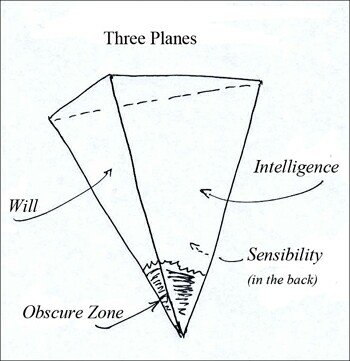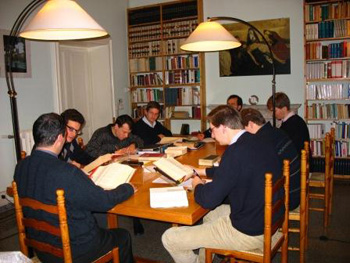 |
Book Reviews
Subverting the Structure of the Soul
Lyle J. Arnold, Jr.
Book review of Destructio Dei - Destruction of God, Vol. 7 of the Collection on Vatican II titled Eli, Eli, Lamma Sabactani? by Atila Sinke Guimarães, Los Angeles: TIA, 2012, 406 pp.
The Book of Genesis (2:7) informs us that God "breathed into Adam's face the breath of life, and man became a living soul.” The Church teaches us that the soul of man is “the substantial form of the body."(1)
St. Augustine and St. Teresa compare the soul to a castle. Prof. Plinio Corrêa de Oliveira departs from the same presupposition when he says that the human soul is architectonic; by this he means that it hosts many individual truths and goodnesses in an harmonic ensemble, just as the architecture of a cathedral encompasses all the elements under its roof - the altars, statues, stain glass windows, sacred vessels, etc. (2)
Now it needs no rational exposition that in the field of architecture, a mislaid foundation, however slight, jeopardizes the entire structure of the building. This principle applies also to a soul. Thus, we can easily comprehend why the progressivists tamper with the very foundation of the soul.
In his newest book Destructio Dei Atila S. Guimarães exposes one of the errors of Fr. Hans Urs von Balthasar's system of thinking. In his “theology of love,” von Balthasar denies the Catholic teaching of the “primacy of the intellect over the will and sentiment” in the soul. He inverted this primacy of the intellect, denying the precedence of the intelligence over the will, since, according to him, “when man awakens to life, the intelligence plays no role whatsoever. Rather, it is only the will that loves.”(3)
Here we can see that Joseph Ratzinger followed von Balthasar, whom he considered a mentor and great theologian, when he affirmed that “only love is necessary for salvation.”(4)
“For von Balthasar, everything in man before his first act of love is a tabula rasa [an empty slate],” Guimarães explains. But this ignores the presence of original sin in human nature, which makes it not a tabula rasa, but rather the opposite, a psychological situation where the inherited corruption must be expunged first by baptism and afterward by a constant discipline.
Thus, before discerning the intellectual errors of von Balthasar, Guimarães points out, it is necessary to understand what the Church teaches, which he sets out with diamond-like clarity. Using the geometric image of a trihedral, an object formed by three planes meeting at a point, he offers a vivid concrete image to represent how the faculties of the soul interact:

Guimarães uses the image of a trihedral to illustrate how the three faculties of soul interact
|
“For didactic purposes, the three faculties of the soul - intelligence, will & sensibility - are always presented separately. However, in fact they have a common point of origin from which they come and to which they return. They would be like the three planes of a trihedral whose lower angle cannot be clearly distinguished because it is immersed in a deep, obscure zone. This zone would be the actual nucleus of the soul where the individualizing unity of each man and his call to the Absolute simultaneously dwell.
“St. Paul seems to refer to this deep reality when he affirms that 'the word of God is living and efficient, and sharper than any two edged sword; piercing even to the dividing asunder of soul and spirit, and of the joints and marrow, and is a discerner of the thoughts and intents of the heart.' (Heb. 4: 12) Others, taking a mystical approach, allude to this zone as the 'tabernacle of the spirit,' 'the heart of the soul' or other similar expressions.”(5)
One “mystical approach” of this “obscure zone” of the soul is worth noting. The passage below of St. Teresa of Jesus captivates the reader by putting into words a charming, intuitive descriptive mystery of the soul, which adds a delightful decoration to the "deep, obscure zone."
“The way in which this that we call union comes, and the nature of it, I do not know how to explain. It is described in mystical theology, but I am unable to use the proper terms, and I cannot understand what is meant by 'mind' or how this differs from 'soul' or 'spirit.' They all seem the same to me, though the soul sometimes issues from itself, like a fire, but that does not make it a different thing: it is the same flame which is in the fire. This, with all your learning, Your Reverences will understand: there is nothing more that I can say of it.” (6)

Seminarians being indoctrinated in von Balthasar's thinking at the Casa Balthasar in Rome, promoted by Pope Ratzinger
|
Thus, von Balthasar and Ratzinger both defend that in the soul the only thing that counts is love. Doing so, they subvert the normal order of the human acting according to which the intelligence is the faculty that discerns and orients, the will is strength that impels the decisions of the intelligence to act, and the sensibility is the charming daughter of both who brings the data from the senses to be taken into consideration and also the one who translates the ideas of the intelligence and the decisions of the will into artistic forms and symbols.
These progressisvists theologians pretend to be sublime by placing love over the reason. Actually what they do is to subvert the order of the human soul and declare the death of the intelligence. They behead the human soul and destine it to complete failure. This leads shortly to every kind of psychological disequilibrium, certainly something we see more and more of in these days.
1. Dictionary of Dogmatic Theology, Parente et al, The Bruce Pub/Co/Milwaukee, 1951, pp. 48, 266.
2. "Wisdom: the Queen of Virtues," Plinio Correa de Oliveira, posted March 15, 2010. Tradition in Action.
3. Destructio Dei, (Destruction of God,) Vol. VII, collection "Eli, Eli, Lamma Sabacthani?" LA: TIA, 2012, p. 200.
4. Progressivist Document of the Week, Tradition in Action, "Fr. Ratzinger: only love is necessary for salvation."
5. A. Guimaraes, Destructio Dei, p. 199.
6. The Life of Teresa of Jesus, autobiography, NY: Image/Doubleday, 1960, new ed. 1991, p. 174.

Posted April 10, 2013

Related Topics of Interest
 Fr. Ratzinger: Only Love Is Necessary for Salvation Fr. Ratzinger: Only Love Is Necessary for Salvation
 Von Balthasar: The Prostitute Is the Symbol of the Church Von Balthasar: The Prostitute Is the Symbol of the Church
 Progressivism's Big Con Progressivism's Big Con
 The Official Hermeneutics of Rupture The Official Hermeneutics of Rupture
 Von Balthasar's on the Relations Between Christ & the Church Von Balthasar's on the Relations Between Christ & the Church
 Wisdom: the Queen of Virtues Wisdom: the Queen of Virtues

|
Book Reviews | Home | Books | CDs | Search | Contact Us | Donate

© 2002-
Tradition in Action, Inc. All Rights Reserved
|
 |

|